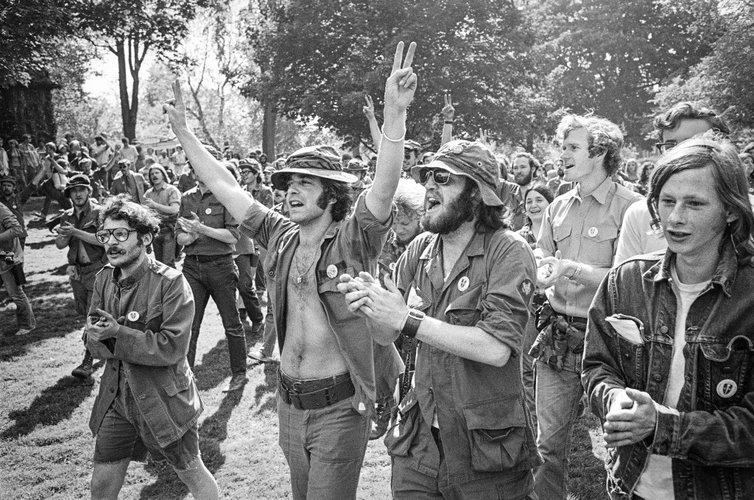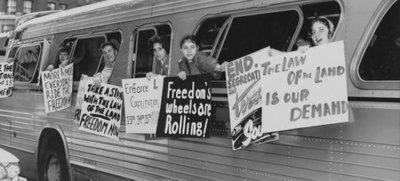11 Resources for Teaching Social Movements Past and Present
Examine 20th century history by looking at events through the lens of the First Amendment.

Vietnam War protesters. (Ted Polumbaum/Newseum Collection)
As you wrap up the school year teaching 20th century history, consider taking an innovative approach this year. Instead of teaching events as separate time periods, look at the threads that run through them, from the Progressive Era to Vietnam to today.
Here's an opportunity to collectively explore social movements and how groups, such as woman suffrage and civil rights activists, used the First Amendment to change society. What strategies and goals did they share? Why did some tactics succeed while others failed?
You'll find extensive free resources that chronicle the events, people and tactics in those fights for change on NewseumED.org. Here are some possible questions for your students to explore, along with sample answers from NewseumED content. Many of the examples come from our curated sets of resources called EDCollections, including “Making a Change: The First Amendment and the Civil Rights Movement,” and “Women, Their Rights and Nothing Less.”
(To access some of these resources, you must be signed into NewseumED; registration is free.)

- How are freedoms of the First Amendment used by leaders and citizens to fight both FOR and AGAINST change? Fifteen years after integration supporters won in the landmark Brown v. Board of Education ruling, white parents and students staged a sit-in at Petal Junior High School in Hattiesburg, Miss. The group refused to attend a former all-black school, per court order.
- What tactics do activists use to promote their cause? Suffragists pioneered the tactic of organized pickets outside the White House. And, as the popular saying goes, the rest is history.
- Why do some tactics fail early in a movement but succeed years later? Media coverage can make or break a movement. In the first protest of its kind, T.J. Jemison led the black residents of Baton Rouge, La., in a boycott of the city’s segregated buses. Read about the factors that led the Baton Rouge boycott to end in a compromise, while the famous Montgomery bus boycott was able to force greater change.
- Define the term “turning point” and identify one in the woman suffrage and civil rights movements. How would history have been different had these turning points not taken place? A turning point is an event with an impact that shapes the events that follow. Examples include the launch of Carrie Chapman Catt's "Winning Plan" in 1915 and "Bloody Sunday" in 1965. By considering the consequences of milestone events and citing evidence of their impact, students develop their knowledge of key chapters in America’s story and exercise critical thinking and communication skills. Here’s a lesson plan to guide the discussion.
- What role does compromise play in bringing about sweeping change? When ideological factions compromise, they can join forces to organize and protest more effectively. For example, in 1890, 21 years after splitting over differences, the National Woman Suffrage Association and American Woman Suffrage Association reunited to form the National American Woman Suffrage Association. They recognized the need to coordinate their efforts in order to win the vote.
- How can news media portrayal or coverage of a social movement influence its direction? News coverage of the Seneca Falls Convention in 1848 and the first national women’s rights convention in 1850 mocked participants and their goals. Elizabeth Cady Stanton said of the criticism: [It] “will start women thinking, and men too; and when men and women think about a new question, the first step in progress is taken.”
- How has technology played a role in social movements? How does the internet and social media play a role today? New technologies, like social media, can make public participation go viral. Leaders of social movements can harness grass-roots efforts to communicate directly with supporters and draw crowds. Howard Dean, Barack Obama and Donald Trump used social media to revolutionize political campaigns and win political loyalties. Before the days of organizing voters and campaigns through social media, the Tammany Society built an influential political network to shape election outcomes. Use our election case study to explore the efficacy of public engagement in the democratic process before and after the social media swirl. How has it helped and hurt the process?
- Can young people overcome a feeling of powerlessness to act and make a difference? Youth today should look to the role of students in the civil rights movement for inspiration. Young people – black and white – played a major role in fighting for racial justice during the 1960s. College students traveled by bus through the South to test segregation policies and organized youth protests and activities, including lunch counter sit-ins.
- How can publishing classified information about controversial government action embolden a movement? The Pentagon Papers were published at a time when the American public remained locked in a heated debate over whether the U.S. should continue fighting the Vietnam War. Whistle-blowers before and since have leaked classified data that they think the public has a right to know about in order to keep the government in check and inform the public about what is happening in their democracy.
- How can anonymous sources and investigative reporting bring about a change at the highest levels of government? Mark Felt, as “Deep Throat,” helped two Washington Post reporters bring down a presidency with their investigative reporting. Our Watergate video lesson tells the story of the Watergate scandal and coverage of it entirely through primary source news footage, without added narration. The use of anonymous sources then — and still today — is hotly debated. Without getting into the discussion of whether Felt was a hero or a traitor, we offer a classroom-ready case study on the reliance on a source who insists on remaining anonymous.
- How long does it take for a social movement to reach its goals? Social movements are usually protracted struggles with lots of ups and downs. Change takes time, as evidenced in our women’s suffrage timeline (1776-1923) and our civil rights timeline (1791-1969).